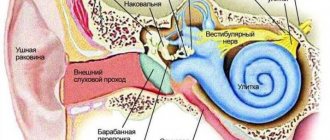How dangerous is the situation when a child breaks a thermometer? Is it necessary to “evacuate” the entire apartment as a result, or is it enough to just do a wet cleaning? What effect does mercury vapor have on children's bodies? What to do if a child swallows mercury? Similar situations occur from time to time in different families, and it is useful for all parents to know how to deal with such cases.
A broken thermometer will not cause serious problems if the spilled mercury is properly disposed of.
Let’s say right away: there is not that much mercury in the thermometer itself, so you shouldn’t worry about poisoning the whole family with its vapors. A thermometer broken by children, which you usually use to measure body temperature, is not a reason to panic - just treat this situation with increased attention. There is no serious danger in such a case, but it can cause some harm to health.
What is the danger?
We know from school that mercury is extremely poisonous. Its vapors, once in the respiratory tract, can either simply make you feel a little worse or seriously disrupt the functioning of your internal organs, depending on the dose received. The most serious consequence is that a person will have to treat diseased internal organs for a long time.
Mercury begins to evaporate when the room temperature exceeds 18°. Vapors enter the body not only during breathing, they can seep through the surface of our skin, however, in the case of very high concentrations in the air.
Mercury vapor affects:
- mucous membrane of the nose and throat;
- gums;
- central nervous system.
Since a child’s body is weaker than an adult, it is, of course, more dangerous for him to be in a room with mercury vapor.
Mercury vapor in high concentrations affects the mucous membranes and can cause problems with the central nervous system.
Publications in the media
Poisoning by mercury vapor and its compounds (ammonium mercury, calomel, merthiolate, sublimate) develops when they enter the body by inhalation, through the skin or orally (the ingestion of metallic mercury is not dangerous), which is possible during the mining of mercury, the production of measuring instruments, pesticides, working with certain dyes (inhalation route), using mercury-containing ointments (mercury gray ointment, yellow mercury ointment). Etiopathogenesis. Mercury is a thiol poison that blocks sulfhydryl groups of enzymes and other proteins • Neurotoxic effect (disturbances in the central nervous system, pronounced tropism for the deep parts of the brain; accumulation in the kidneys) • Sublimate (mercury dichloride) also has enterotoxic and cauterizing effects • Salts of monovalent mercury (Hg+ ) compared to divalent (Hg2+) are less soluble and less toxic.
Clinical picture • Acute intoxication with mercury vapor - headache, fever, diarrhea, vomiting, a few days later - hemorrhagic syndrome, ulcerative stomatitis, gingivitis; in severe cases - acute cardiovascular failure, anuria. Possible interstitial pneumonia • Acute poisoning with mercuric chloride •• Upon admission - sharp pain in the abdomen, along the esophagus, vomiting, diarrhea (often with blood). Metallic taste in the mouth, drooling, bleeding gums; copper-red coloring of the mucous membranes of the mouth and pharynx, later - a dark border of sulfurous mercury on the gums, ulcerative stomatitis, gingivitis. On days 2–3 - acute renal failure, signs of central nervous system damage, anemia •• In case of contact with the skin and mucous membranes - burns • Chronic intoxication •• Initial stage - astheno-neurotic syndrome (irritability, weakness, headache, restless sleep), minor, irregular tremor of the fingers, tachycardia, increased sweating, possible symptoms of hyperthyroidism, ovarian dysfunction •• In the future ••• Psychoneurological disorders - a symptom of mercury erethism - timidity, self-doubt; with excitement - palpitations, sweating, facial flushing. Severe headaches, irritability, insomnia, nightmares. Encephalopathy, tremors of the limbs, possible psychosis. Severe vascular instability, cardialgia ••• Mercury lens (brown coloring of the anterior part of the lens) ••• Gingivitis and stomatitis ••• Progressive kidney damage.
TREATMENT Regimen • In case of acute poisoning - hospitalization in a poison control center • In case of chronic intoxication in the initial stage - outpatient or sanatorium treatment, transfer to work without contact with mercury; in case of severe manifestations - hospital treatment, transfer to another job. Management tactics • For acute oral poisoning with mercury compounds - gastric lavage through a tube followed by the introduction of enterosorbent (activated carbon) • Specific (antidote) therapy • Early hemodialysis • Infusion therapy, correction of water-electrolyte status • Bilateral perinephric procaine blockade • Symptomatic therapy - treatment OPN, antibiotics, analgesics, vitamins. Specific (antidote) therapy (see also Lead poisoning and its compounds) • Sodium dimercaptopropanesulfonate 3–5 mg/kg (0.1 ml/kg 5% solution) deep IM every 6 hours for 5–7 days • Thetacine-calcium 150 mg/kg/day for 5 days (10 ml of 10% solution) • Sodium thiosulfate (100 ml of 30% solution) IV drip • Succimer - 10 mg/kg every 8 hours for 5 days, then 10 mg/kg every 12 hours for 2 weeks • Long-term penicillamine (3–6 months).
Prognosis • Quite serious (especially in case of sublimate poisoning) and depends on the amount of toxic substance (lethal dose of sublimate about 0.5 g) and timeliness of assistance provided • Prolonged contact with mercury can cause chronic renal failure.
ICD-10 • T56.1 Toxic effects of mercury and its compounds
What to do if a thermometer is broken in the house
A thermometer, of course, is not a toy, and you shouldn’t give it to children again, but anything can happen. If your child has broken a thermometer, you need to quickly:
- take the baby out of the room;
- remove fragments of a broken device;
- collect and dispose of mercury balls.
Keep in mind that mercury balls are very mobile and have the ability to seep into any cracks in the floor. Once stuck there, the mercury will begin to evaporate, posing a threat to the health of children specifically - after all, children are closer to the floor than we are. The mercury balls are small, so collecting them is quite difficult, and with poor lighting, sometimes you can’t even see small drops.
Disposal requirements
Self-disposal is a step-by-step set of actions. The following tools will help you clean up:
- adhesive tape, plaster, electrical tape;
- flashlight - illuminate hard-to-reach areas;
- two sheets of thick paper (you cannot use a broom or vacuum cleaner);
- cotton wool;
- syringe or medical bulb.
Do not collect spilled mercury with a vacuum cleaner. Firstly, it will evaporate even faster, and secondly, it will not be possible to clean the vacuum cleaner; it will be easier to destroy it.
Please note that collecting mercury balls with a broom is extremely inconvenient: you will simply drive them across the floor. Pieces of paper are much more reliable in this case.
It is better to dispose of spilled mercury using a rubber bulb or a medical syringe.
You will also have to cook in glass jars:
- soap and soda solution for cleaning the floor;
- high concentration manganese solution;
- ordinary water, put fragments of a thermometer and mercury in it.
We do the cleaning
Next, perform the following operations.
- Close the doors, removing both children and adults from the room.
- Put rubber slippers (preferably shoe covers) on your feet, a damp cloth mask on your face, and thick gloves on your hands.
- Soak a rag in a manganese solution and lay it at the entrance, at the same time tightly plugging the gap under the doors with it.
- Open the windows, so the mercury vapor will disappear faster.
- Collect the broken thermometer fragments in a jar of water. Be careful so that the remaining mercury in the flask does not spill out.
- Using two sheets of paper, collect the mercury balls into a single puddle, then distill it onto a sheet of paper and place it in a jar of water to the “remains” of the thermometer.
- Using adhesive tape, collect the remaining small balls, also placing them in a jar.
- Mercury that has flowed into the cracks of the parquet and under the baseboard is removed using a bulb (syringe). Use a flashlight to illuminate the balls; in the light the balls will sparkle with a metallic color.
- Next, close the jar with a tight lid and begin to wash the floor - first with manganese and then with a soap solution.
During cleaning, it is necessary to take measures to protect the respiratory system and skin.
After cleaning up, put the slippers, gloves, and bandage in one bag along with the jar where the collected fragments and mercury are stored. Now it is advisable to find out where to put the waste: such dangerous things are not thrown away with ordinary garbage. Call the Ministry of Emergency Situations and specify the disposal location.
Clothes contaminated with mercury must be disposed of; they cannot be washed. It is forbidden to flush collected mercury down the toilet.
What are the symptoms of vapor poisoning?
If a child is poisoned with mercury, bed rest is indicated and immediate medical attention is required.
It is much worse if a child holds mercury balls in his hands for a long time, then the vapors of this substance will affect the body through the respiratory tract. With prolonged contact with mercury vapor, the following signs of poisoning may appear:
- drowsiness;
- unusual behavior (irritability, apathy, lethargy);
- dizziness;
- frequent headaches;
- memory impairment, decreased attentiveness;
- increased fatigue;
- rapid heartbeat, arrhythmia;
- tremor of the limbs;
- uneven difficulty breathing, cough;
- increased sweating;
- frequent urination;
- perverted taste sensations;
- dry mouth with active secretion of saliva;
- increase in body temperature to 39-40 degrees.
Quarantine measures
Taking care of the health of loved ones, it is better to temporarily, for about a week, make the room where the thermometer was broken uninhabited. Open the windows there and constantly ventilate, wash the floor daily with soap and soda solution.
It is extremely important to close the door to the room - you do not need drafts in an infected room.
If you are very concerned about the risk of vapor poisoning, simply call the laboratory service. From there they will bring special instruments and measure the level of mercury concentration in the room and near the floor.
The child bit through the thermometer and swallowed mercury
Sometimes it turns out that they didn’t keep an eye on the child and came after the incident, and it’s quite possible that the baby, having “crashed” a useful thing, at the same time tried the cute mercury balls that rolled out of the broken thermometer on his tongue and even swallowed it. The situation is, of course, unpleasant, but, we repeat, not particularly critical, since the concentration of mercury in household appliances is too low to pose a serious threat to the child’s body.
A child who has swallowed mercury from a thermometer should be shown to a doctor.
But it is still necessary to show the baby to a doctor. Sometimes the baby does not drop the thermometer, but, for example, bites it, chews it, and as a result scratches his tongue, lips with fragments, and often swallows a fragment, and in such a case the consequences are much more dangerous than mercury in low concentrations.
Why is mercury from a broken thermometer dangerous?
In an open environment, mercury breaks up into small moving balls, which quickly roll into corners and crevices. These balls begin to evaporate already at a temperature of 18C, poisoning the air.
Basically, mercury vapor is inhaled through the lungs, after which it settles on the internal organs. Mercury vapor seriously harms health even at low concentrations.
It is believed that ingested mercury is not as dangerous as fumes and is easily excreted through the gastrointestinal tract. However, if a child bit through the thermometer and swallowed mercury, sharp glass shards could also enter the body.
Symptoms of mercury vapor poisoning
Fearing that during your absence the child inhaled mercury, bit off the tip of the thermometer and drank the contents, keep an eye on the baby. Poisoning can be recognized by the following signs:
- the baby quickly weakens and behaves apathetically;
- drowsiness will appear, the baby will feel dizzy;
- the pulse will become rapid;
- the child often wants to go to the toilet and sweats profusely;
- his arms and legs are shaking;
- The baby becomes inattentive and memory deteriorates.
Consequences
As a result of poisoning, unpleasant consequences will soon arise, fraught with complications:
- possible development of pneumonia, hypotension;
- the functioning of the thyroid gland will go wrong;
- hypertension will occur;
- pathologies will appear in the functioning of the kidneys, liver and gall bladder;
- the risk of tuberculosis and atherosclerosis increases.
Poisoning with concentrated mercury vapor can lead to serious pathologies.
Characteristics of mercury
Mercury is an element classified as hazard class I. It is a transition metal, which is a silvery-white liquid with a large mass. In a vapor state, it is extremely toxic at a room temperature of 14-25 degrees. Metallic mercury itself does not poison the human body, unlike vapors and soluble compounds, especially organic ones, which belong to the group of cumulative poisons. Even a very small dose of mercury can cause serious disruption to the body and cause harm to health.
Metal poisons the entire body, especially affecting the gastrointestinal tract, immune, respiratory and nervous systems, kidneys, liver, skin and eyes. Despite the toxicity of mercury, it is actively used in various areas of the national economy. The most familiar device to us is a mercury thermometer for measuring body temperature, which is found in every home.
Fortunately, mercury poisoning from a broken thermometer does not happen often; they can be detected in family members where basic safety rules are not followed, thermometers are regularly damaged and the premises are not decontaminated. In this case, chronic symptoms may occur. Acute poisoning occurs when several fluorescent energy-saving light bulbs are broken.
Ways to remove mercury vapor from the body
Our body is quite capable of removing the heavy metals that have entered it. After all, mercury can accumulate in us not only when living in an apartment full of broken thermometers. There is also a lot of it in:
- some seafood;
- polluted air;
- poor quality drinking water;
- household chemicals;
- ointments and whitening creams.
There are several ways to help the body cleanse itself of accumulated mercury.
- Make a decoction of coriander (cilantro): pour 8 teaspoons of finely chopped herbs into a liter of boiling water, then leave for about half an hour. Drink coriander decoction, replacing regular tea, for a couple of months. Brew the decoction only in glass containers, but not in metal ones.
- Take a decoction of burdock roots. 10 grams of dried plant roots are poured with a glass of boiling water, then boiled over low heat for a quarter of an hour. The broth is filtered. You need to drink a tablespoon three times a day.
- Follow a special diet with plenty of seaweed, carrots, beets - such products themselves remove heavy metals or make them more inert.
Remember: the process of removing mercury from the body takes quite a long time, so be patient.
A decoction of burdock roots will help remove mercury vapor from the body.
Expert opinion:
People can be exposed to mercury by breathing contaminated air, drinking contaminated water or food (such as fish), or getting mercury on their skin. When you ingest a small amount of metallic mercury, such as from a broken thermometer, virtually less than 0.01% of the mercury will enter your body through the stomach or intestines, unless there are ulcers or serious digestive pathologies. Even a larger amount of metallic mercury (half a tablespoon) swallowed by a person practically does not penetrate the body. However, when you inhale mercury vapor, most (about 80%) of the mercury enters your bloodstream directly from the lungs and then quickly travels to other parts of your body, including the brain and kidneys. Mercury vapor or heavy metal salts can affect different areas of the brain and related functions, causing various symptoms. These include personality changes (irritability, aggression, nervousness), tremors, changes in vision (narrowing field of view), deafness, muscle incoordination, loss of touch, and memory problems.
Alena Paretskaya, pediatrician
Prevention of disaster
Young children have to take their temperature quite often. Therefore, it is better to buy not an ordinary thermometer for your home, but a special safe one - infrared and electronic. The baby will no longer be able to see through the tip of this device, bite it off no matter how hard he tries, and it is much more convenient to use such a device - the temperature values are clearly visible on the electronic display.
Using a mercury thermometer the old fashioned way, follow the rules:
- Do not give the device to small children.
- Store the device in a special case and out of the reach of children.
- When measuring your baby's temperature, carefully hold his hand.
- When shaking the device, keep your hand away from objects that could easily break it.
0 0 votes
Article rating
Good to know: what to do when a child swallows a foreign object, how to stop nosebleeds. Read these articles because an emergency situation can arise at any time.









